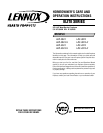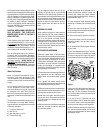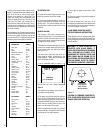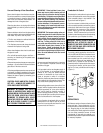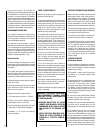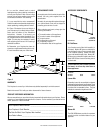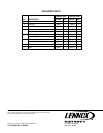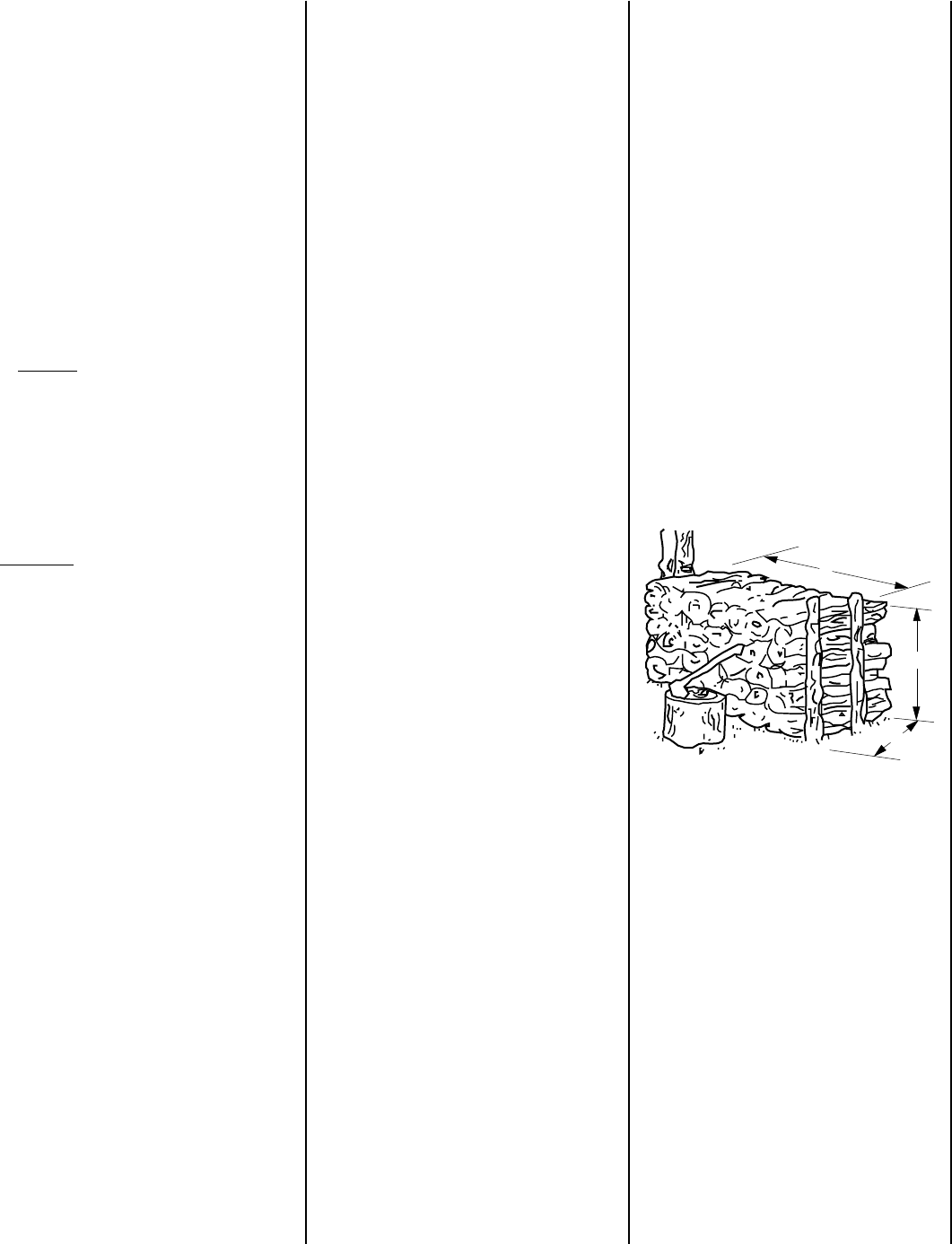
3
NOTE: DIAGRAMS & ILLUSTRATIONS NOT TO SCALE.
The last statement means that one big log
weighing 10 pounds has as much heating
potential as 10 pounds of twigs. However, air
cannot get at the solid log to feed the fire so the
solid log will burn slowly. While you would get
the same amount of heat out of either fire, the
smaller the pieces of wood and the more air
space around them, the faster the fire will
burn.
DISPOSAL OF ASHES
Ashes should be placed in a metal container
with a tight fitting lid. The closed container of
ashes should be placed on a noncombustible
floor or on the ground, well away from all
combustible materials, pending final disposal.
If the ashes are to be disposed of by burial in soil
or other wise locally dispersed, they should be
retained in the closed container until all cinders
have thoroughly cooled.
SOFTWOOD VS HARDWOOD
Softwoods contain about 15 percent highly
flammable resin which generates creosote soot
in the chimney flue. Burning softwood exclu-
sively may not be as desirable nor as safe as
burning denser hardwoods. Many experienced
fire-builders use small amounts of softwood
kindling and newspaper in conjunction with
starting a fire with split hardwood logs. Here are
some guidelines to remember:
1. Softwoods produce fast warming and shorter
fires. Hardwoods burn less vigorously, have
shorter flames and produce steady, glowing
coals.
2. As a general rule, denser woods contain
more potential heat per pound. Most softwoods
offer moderate heat value per pound.
3. Different woods vary widely in flame heights,
flame intensities, smoke characteristics and in
sparking. Most hardwoods do not spark.
4. Most freshly cut “green” wood will not burn
well and will smoke. Green wood can be from
10 to 40 percent less efficient than air-dried
seasoned wood.
5. Moisture and resin found inside unseasoned
wood cells will build up pressure under heat
and explode as sparks.
A face cord is the same height and length as a
standard cord but the depth is only the length
of the logs (12, 18 or 24 inches). A face cord
can contain as little as 25% of the wood found
in a standard cord.
If you buy by the ton, remember that wood
becomes lighter as it dries. When buying green
or wet wood, ask for some extra poundage to
allow for the extra water you will be getting.
9. When comparing woods of the same mois-
ture content and same species, we find most
woods have approximately the same heating
potential per pound.
4'
4'
8'
Standard
Cord of
Wood
Figure 1
This fireplace has been tested and approved for
use with a decorative gas appliance incorporat-
ing an automatic shut-off device and complying
with the Standard for Decorative Gas Appli-
ances for installation in vented fireplaces, ANSI
Z21.60 (1991). Decorative gas appliances may
be installed in these fireplaces. Installation
must be in accordance with the national Fuel
Gas Code, ANSI Z223.1 for compliance with the
revised U.L. 127 Standard.
CAUTION: WHEN USING A DECORATIVE
GAS APPLIANCE, THE FIREPLACE
DAMPER MUST BE SET TO THE FULLY
OPEN POSITION.
These fireplaces have been tested and ap-
proved to ANSI/IAS/AGA Z21.11.2 for use with
an
unvented gas appliance having a maximum
rating of 40,000 BTU and complies with the
Standard for Factory-Built Fireplaces, U.L. 127,
when installed with unvented gas log sets.
Prior to installing any gas log set, (Vented or
Unvented) refer to the fireplace installation
instructions for verification of mantle heights
and placement of combustible materials around
the firebox opening. NEVER INSTALL AN
UNVENTED GAS LOG SET WITH A BTU RAT-
ING GREATER THAN 40,000 BTU. Vented gas
log sets do not have restrictions placed upon
their BTU rating.
Wood Fuel Pointers
Wood is a wonderful renewable fuel source.
Normally it burns clean, leaving only a mini-
mum of waste ash, provides comforting heat
and can provide a variety of aromas and visual
images.
You will want to know which woods are best
for use. Sometimes you may want a quick,
short fire to offset a morning chill. Soft woods
are preferable in this case. Other times you
would want more slow burning and a uniform
heat output. Hardwoods are preferable for this
use.
The amount of heat available from the logs will
be about equal on a weight basis. However,
logs are generally not weighed so the amount
of heat will depend on:
1. The type of wood used.
2. How dry it is.
3. How many logs you put in.
4. The size of the logs.
6. Most wood needs to be seasoned 9 to 12
months to reduce the moisture content and
produce good steady fires. When moisture
content is reduced from 60 to 20%, the gain in
heat potential is nearly 7%.
7. Proper storage of wood, especially during
seasoning, is essential. We recommend that
you:
a. Never store wood on the ground. This will
cause rotting and insect infiltration. Raise wood
on flat rock or scrap wood.
b. Stack wood loosely to allow air circulation.
c. Store wood where it will not be excessively
exposed to weather, such as under a tarp or
under a roof.
d. Do not stack wood directly against the walls
of your home.
8. Be a knowledgeable wood buyer. There is a
difference in cord sizes. A standard cord stack
of logs is 4 ft. high by 8 ft. long by 4 ft. deep or
the equivalent of this cubic footage, (
Figure 1
).



